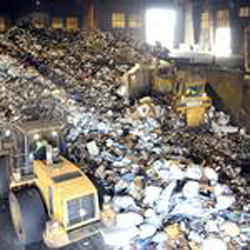Covanta Fined a Pittance as Neighbors Downwind of Covanta Smokestack Will Get Full Dose of Toxic Garbage Ash
By Frank Parlato
 |
Covanta Niagara, a garbage burning plant that makes two-thirds of its profits from burning garbage taken from other cities, and about 20 percent from the electricity and steam generated from burning the garbage (and the rest from scrapping metals found or burnt out of garbage), is going to pay a miniscule fine of $67,500 to the New York State Department of Environmental Conservation (DEC) because it built a 190-foot smokestack without getting a permit.
The smokestack is part of a new, heavily-polluting $10.5 million expansion project that will see Niagara Falls take in and burn half-a-million more tons of New York City garbage a year.
The newly built, illegal smokestack will release New York City pollution into our friendly skies in the heart of LaSalle.
The people in NYC, of course, are too smart to burn it there and their laws, wisely, don't permit it. But, our green mayor, Paul Dyster, not only supported the deal, but worked hard to lavish Covanta with helpful tax incentives and fast track planning approval.
The smokestack is part of Covanta's newly planned boiler system, which will burn garbage and release residue (observed as black looking smoke) much of it containing cancerous pollution.
Since the black smoke will be released out of the new smokestack 190 feet into the air, it will be carried in the wind, away from the people who work at the plant. Thanks to gravity, it will land on the earth at least a few hundred yards away, and find its way into the good people's lungs, downwind from the plant, located on 56th street near Niagara Falls Blvd.
While other cities have rejected Covanta polluting incinerators due to "adverse environmental impacts," it has found a home in Niagara Falls.
Happily for Covanta Niagara, the polluting company will not be required by the DEC to take down their $2 million illegal smokestack. They will pay the $67,500 fine, which is less than four percent of the cost of the smokestack. To put it in perspective, if someone built a $100,000 home without a permit or building inspections, he or she would pay a $330 fine.
Clearly, it's easier to ask forgiveness than to get permission.
Covanta would have gotten away without a fine had it not been for a gadfly named Amy Hope Witryol of Lewiston, who noticed what was going on, did some checking, and started complaining.
Of course, the DEC ignored her, so she took it to the Niagara Gazette which stuck their investigative nose into it.
This apparently spooked the DEC enough to tell (ask?) Covanta they were going to get a mild slap on the wrist.
Covanta's NYC garbage burning plans include, besides the pollution-spewing garbage-burning boiler and (illegal) smokestack, the construction of rail
road tracks - to bring in more garbage.
Other than Witryol and other gadflies, like Chris Kudela and Shirley Hamilton, who also complained, no one is likely to care much about this issue. The wise people of Niagara Falls will continue to ignore every major issue of importance to their health and economic welfare.
Covanta, of course, is saying the new rails will result in the creation of 23 new garbage burning jobs (our growth industry). It was the argument used to sell the project to the Niagara County IDA and get Covanta $8 million in tax reductions and incentives on their $10.5 million project. There is poetic justice in that: Covanta will get almost 80 percent of their new bring-me-your-garbage-project paid for by the people breathing in the pollution who don't have the brains to complain.
That Covanta pretends to be an "energy company" is a spin so monumentally false that it's actually brilliant. Think of that smokestack as Pinocchio's nose and you get the idea. True, the byproduct of burning garbage is that some steam and electrical energy is produced. That energy is not green because a lot of pollution is created to make that energy.
On top of that, the company does not give away the energy to the people whose lungs they are polluting - so they could save enough money to move upwind from the plant.
Instead, they sell the energy to (oftentimes polluting) companies for market value.
The DEC could have required Covanta to dismantle the boiler and smokestack to deter other polluters not to build smokestacks first, and pay small fines later. But the DEC chose to enable Covanta, which last August signed a 30-year contract with the New York City Department of Sanitation to bring in 500,000 tons of municipal waste transported by rail to the Niagara Falls plant each year.